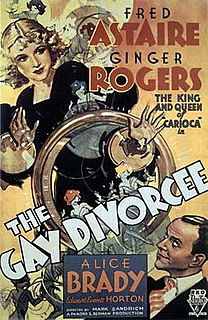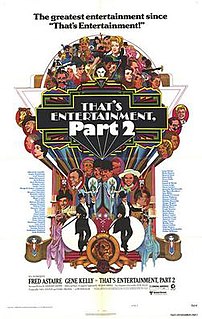
The Gay Divorcee is a 1934 American musical film directed by Mark Sandrich and starring Fred Astaire and Ginger Rogers. It also features Alice Brady, Edward Everett Horton, Eric Blore, and Erik Rhodes. The screenplay was written by George Marion Jr., Dorothy Yost, and Edward Kaufman. Robert Benchley, H. W. Hanemann, and Stanley Rauh made uncredited contributions to the dialogue. It was based on the Broadway musical Gay Divorce, written by Dwight Taylor, which had been adapted into a musical by Kenneth S. Webb and Samuel Hoffenstein from an unproduced play by J. Hartley Manners.

Ginger Rogers was an American actress, dancer and singer during the Golden Age of Hollywood. She won an Academy Award for Best Actress for her starring role in Kitty Foyle (1940), and performed during the 1930s in RKO's musical films with Fred Astaire. Her career continued on stage, radio and television throughout much of the 20th century.

Holiday Inn is a 1942 American musical film starring Bing Crosby and Fred Astaire, with Marjorie Reynolds, Virginia Dale, and Walter Abel. It was directed by Mark Sandrich with music by Irving Berlin. The composer wrote twelve songs specifically for the film, the best known being "White Christmas". The film features a complete reuse of the song "Easter Parade", written by Berlin for the 1933 Broadway revue As Thousands Cheer and used as a highlight of the 1948 film, Easter Parade starring Astaire and Judy Garland. The film's choreography was by Danny Dare.

Betty Hutton was an American stage, film, and television actress, comedian, dancer, and singer.

Swing Time is a 1936 American musical comedy film, the sixth of ten starring Fred Astaire and Ginger Rogers. Directed by George Stevens for RKO, it features Helen Broderick, Victor Moore, Betty Furness, Eric Blore and Georges Metaxa, with music by Jerome Kern and lyrics by Dorothy Fields. Set mainly in New York City, the film follows a gambler and dancer, "Lucky" (Astaire), who is trying to raise money to secure his marriage when he meets dance instructor Penny (Rogers) and begins dancing with her; the two soon fall in love and are forced to reconcile their feelings.

That's Entertainment! III is a 1994 American documentary film released by Metro-Goldwyn-Mayer to celebrate the studio's 70th anniversary. It was the third in a series of retrospectives that began with the first That's Entertainment! (1974) and That's Entertainment, Part II (1976). Although posters and home video packaging use the title without an exclamation mark, the actual on-screen title of the film uses it.

Flying Down to Rio is a 1933 American pre-Code RKO musical film famous for being the first screen pairing of Fred Astaire and Ginger Rogers, although Dolores del Río and Gene Raymond received top billing and the leading roles. Among the featured players are Franklin Pangborn and Eric Blore. The songs in the film were written by Vincent Youmans (music), Gus Kahn and Edward Eliscu (lyrics), with musical direction and additional music by Max Steiner. During the initial year that a Best Original Song was given during 7th Academy Awards, the film obtained a nomination for MUSIC (Song) – "Carioca," Music by Vincent Youmans; Lyrics by Edward Eliscu and Gus Kahn [came in 3rd]. Ironically, the song lost to "The Continental" from The Gay Divorcee, the subsequent film of Fred Astaire and Ginger Rogers after Flying Down to Rio.

Hermes Pan was an American dancer and choreographer, principally remembered as Fred Astaire's choreographic collaborator on the famous 1930s movie musicals starring Astaire and Ginger Rogers. He worked on nearly two dozen films and TV shows with Astaire. He won both an Oscar and an Emmy for his dance direction.

That's Entertainment, Part II is a 1976 American compilation film released by Metro-Goldwyn-Mayer and a sequel to That's Entertainment! (1974). Like the previous film, That's Entertainment, Part II was a retrospective of famous films released by MGM from the 1930s to the 1950s.

White Christmas is a 1954 American musical film directed by Michael Curtiz and starring Bing Crosby, Danny Kaye, Rosemary Clooney, and Vera-Ellen. Filmed in Technicolor, it features the songs of Irving Berlin, including a new version of the title song, "White Christmas", introduced by Crosby in the 1942 film Holiday Inn.

Follow the Fleet is a 1936 American RKO musical comedy film with a nautical theme starring Fred Astaire and Ginger Rogers in their fifth collaboration as dance partners. It also features Randolph Scott, Harriet Hilliard, and Astrid Allwyn, with music and lyrics by Irving Berlin. Lucille Ball and Betty Grable also appear, in supporting roles. The film was directed by Mark Sandrich with script by Allan Scott and Dwight Taylor based on the 1922 play Shore Leave by Hubert Osborne.

Daddy Long Legs (1955) is a Hollywood musical comedy film set in France, New York City, and the fictional college town of Walston, Massachusetts. The film was directed by Jean Negulesco, and stars Fred Astaire, Leslie Caron, Terry Moore, Fred Clark, and Thelma Ritter, with music and lyrics by Johnny Mercer. The screenplay was written by Phoebe Ephron and Henry Ephron, loosely based on the 1912 novel Daddy-Long-Legs by Jean Webster.

Carefree is a 1938 musical film starring Fred Astaire and Ginger Rogers. With a plot similar to screwball comedies of the period, Carefree is the shortest of the Astaire-Rogers films, featuring only four musical numbers. Carefree is often remembered as the film in which Astaire and Rogers shared a long on-screen kiss at the conclusion of their dance to "I Used to Be Color Blind," all previous kisses having been either quick pecks or simply implied.

Shall We Dance, released in 1937, is the seventh of the ten Fred Astaire-Ginger Rogers musical comedy films. The story follows an American ballet dancer (Astaire) who falls in love with a tap dancer (Rogers); the tabloid press concocts a story of their marriage, after which life imitates art. George Gershwin wrote the symphonic underscore and Ira Gershwin the lyrics, for their second Hollywood musical.

Shepperd Strudwick was an American actor of film, television, and stage. He was also billed as John Shepperd for some of his films and for his acting on stage in New York.
"Let's Call the Whole Thing Off" is a song written by George Gershwin and Ira Gershwin for the 1937 film Shall We Dance, where it was introduced by Fred Astaire and Ginger Rogers as part of a celebrated dance duet on roller skates. The sheet music has the tempo marking of "Brightly". The song was ranked No. 34 on AFI's 100 Years...100 Songs.

Finian's Rainbow is a 1968 musical fantasy film directed by Francis Ford Coppola and starring Fred Astaire and Petula Clark. The screenplay by E.Y. Harburg and Fred Saidy is based on their 1947 stage musical of the same name. An international co-production of Ireland and the United States, the film follows an Irishman and his daughter who steal a leprechaun's magic pot of gold and emigrate to the U.S., where they become involved in a dispute between rural landowners and a greedy, racist U.S. senator.

Annie Get Your Gun is a 1950 American musical Technicolor comedy film loosely based on the life of sharpshooter Annie Oakley. The Metro-Goldwyn-Mayer release, with music and lyrics by Irving Berlin and a screenplay by Sidney Sheldon based on the 1946 stage musical of the same name, was directed by George Sidney. Despite several production and casting problems, the film won the Academy Award for Best Scoring of a Musical Picture and received three other nominations. Star Betty Hutton was recognized with a Golden Globe nomination for Best Actress.

Roberta is a 1935 American musical film by RKO starring Irene Dunne, Fred Astaire, Ginger Rogers, and Randolph Scott. It was an adaptation of the 1933 Broadway musical Roberta, which in turn was based on the novel Gowns by Roberta by Alice Duer Miller. It was a solid hit, showing a net profit of more than three-quarters of a million dollars.

Fred Astaire and Ginger Rogers were dance partners in a total of 10 films, nine of them with RKO Radio Pictures from 1933 to 1939, and one, The Barkleys of Broadway, with MGM in 1949, their only color film.



















